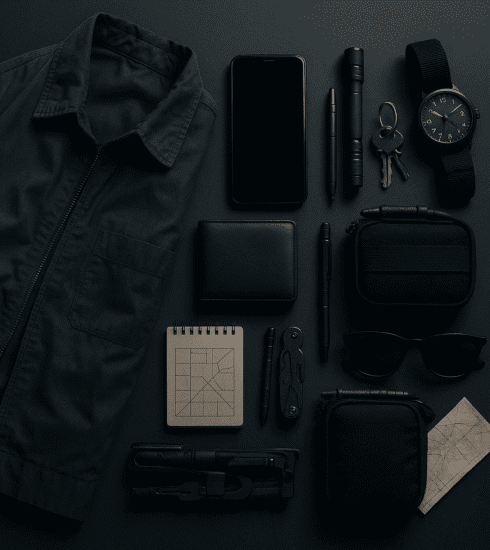Airport Travel EDC: Legal, Useful, Boring
Airport travel presents a unique set of challenges that demand a carefully considered approach to your everyday carry. The goal is not to stand out or to prepare for cinematic scenarios. It is to move through the terminal with quiet efficiency, legal compliance, and a focus on your primary mission, which is reaching your destination without incident. Your airport travel EDC must be a study in deliberate minimalism, prioritizing function and fluidity over any form of aggressive posturing. Every item you select must serve a clear purpose and pass the scrutiny of both security personnel and common sense. This is about adopting a gray man mindset in a high stress environment where awareness is your greatest asset. The system you build should be legal, useful, and ultimately boring to anyone who might glance your way.
The terminal is a non permissive environment. Your objective is transit, not confrontation. Your gear must reflect that reality with absolute clarity.
Establishing Your Foundational Mindset for Terminal Navigation
The core principle of your airport EDC begins long before you pack a bag. Your mindset is the most critical component you will carry. You are entering a controlled space with layers of security and constant observation. Your behavior and your possessions must align completely with the environment’s rules and expectations. Any deviation, however minor, can create friction and unnecessary delays. The professional understands that compliance is a tactical choice that facilitates smooth and efficient movement. You are not there to test boundaries or prove a point.
Adopt the perspective of a systems operator. Your goal is to interface seamlessly with the airport’s processes from curb to gate. This requires pre flight verification of all regulations regarding carry on items and prohibited materials. A simple oversight with a forgotten multitool or a questionable battery pack can derail your entire itinerary. The time for verifying your loadout is the night before travel, not at the security screening checkpoint. This proactive approach eliminates the most common points of failure before they can manifest. It is a simple discipline that pays significant dividends.
Selecting a Platform for Efficient and Compliant Carry
Your choice of bag sets the stage for your entire airport travel EDC experience. The ideal platform is a well constructed backpack or a slim briefcase with a clean, professional appearance. It should open fully like a clamshell to allow for rapid visual inspection by Transportation Security Administration officers. Avoid bags with an excessive number of compartments, molle webbing, or tactical aesthetics that might draw undue attention. The color should be neutral, such as black, gray, or navy, helping you blend into the background of busy travelers. Your bag is a tool for organization, not a statement of identity.
Internal organization is paramount for maintaining efficiency and demonstrating compliance. Use pouches or organizers to group similar items together, such as cables and electronics. This allows you to quickly present these items in a bin if requested and prevents a disorganized spill of contents during screening. Keep your laptop or tablet in a easily accessible sleeve to streamline the process of removing it for separate screening. A place for everything and everything in its place is not just a saying. It is a operational requirement for moving through security with speed and minimal interaction.
Your bag should open like a book for security. A clamshell design demonstrates you have nothing to hide and respects the screener’s need for a clear, quick view.
Curating the Core Contents of Your Carry On Bag
The electronics you carry must be essential and well documented. Your laptop, tablet, phone, and their associated chargers and cables form the backbone of a modern travel kit. Use a dedicated organizer to keep cables from tangling and to present a neat package. Verify that all power banks are within the legal watt hour limits for air travel and that their capacity is clearly marked on the device itself. Carry only the devices you need for the trip itself. Extraneous electronics add weight and complexity to the security screening process. Every item should have a defined purpose for the journey ahead.
Personal comfort and health items are a force multiplier during long travel days. Noise canceling headphones are an invaluable tool for maintaining focus and reducing ambient stress in a crowded terminal. A reusable water bottle, filled after you pass through security, ensures you stay hydrated without relying on airport vendors. Include any essential medications in their original prescription bottles, clearly labeled with your name. A small first aid kit with basics like bandages, pain relievers, and antiseptic wipes can handle minor inconveniences. These items support your resilience and readiness without drawing any attention.
Documentation is a critical element that requires meticulous attention. Your passport, boarding pass, and identification must be immediately accessible in a dedicated pocket or holder. I recommend carrying physical copies of important documents as a backup to digital versions stored on your phone. Include contact information for your airline and a list of emergency contacts. A pen is a simple but vital tool for filling out any required paperwork. Your documentation suite must be organized, verifiable, and ready for presentation at a moment’s notice.
Navigating the Security Screening Checkpoint with Precision
Your approach to the security line begins with observation and verification of the specific requirements. Different airports and countries can have slightly varying procedures. Take a moment to assess the flow of the line and listen for any instructions from TSA personnel. Have your ID and boarding pass ready in your hand before you reach the front of the line. This demonstrates preparedness and respect for the process, making the interaction smooth and professional. Your demeanor should be calm, cooperative, and quiet.
The mechanical process of preparing your items for the X ray machine is where preparation pays off. Place your laptop or tablet in its own bin first, followed by your quart sized bag of liquids if you carry them. Your shoes, belt, and any metal objects should go into another bin. Your empty bag goes directly onto the conveyor belt. The goal is to create a clear, unambiguous image for the screener. A messy bin with overlapping items often triggers a need for a secondary search, costing you valuable time. Efficiency here is a form of professional courtesy.
If you are selected for additional screening, your response must remain calm and compliant. The vast majority of these screenings are random or the result of a minor anomaly on the X ray. Answer any questions directly and without offering unnecessary commentary. Keep your hands visible and follow instructions precisely. Your entire airport travel EDC is designed to be non threatening and easily explained, which simplifies this process. Your cooperative attitude can turn a potential delay into a brief, professional exchange. Remember that the officers are performing a necessary job.
Maintaining Situational Awareness from Curbside to Jet Bridge
Awareness is your primary defensive tool in the terminal environment. This does not mean adopting a paranoid or aggressive posture. It means consciously noting your surroundings, identifying exits, and observing the patterns of movement around you. Keep your bag in physical contact with your person at all times, either on your back or between your feet if you are seated. Avoid becoming overly absorbed in your phone screen, which creates a significant vulnerability. The professional maintains a relaxed but alert state, processing information without appearing to do so.
Blending in is a key component of awareness. Dress in a manner that is comfortable but conforms to general business casual norms. This allows you to move through all areas of the airport without standing out. Avoid clothing with provocative slogans, overtly tactical designs, or anything that might mark you as an individual worth a second glance. Your entire presentation, from your bag to your clothing, should signal that you are just another person trying to catch a flight. This low profile is the essence of the gray man principle in a travel context.
Your positioning while waiting at the gate or in a terminal restaurant should be deliberate. Choose a seat that places your back to a wall or a corner, giving you a clear field of view of the area. This is a simple habit that reduces your vulnerability and increases your ability to observe. Keep your belongings consolidated and within your control. This mindful positioning is not about expecting trouble. It is about practicing good operational security as a matter of routine. These small habits compound to create a significant layer of personal security.
Addressing Common Contingencies with a Calm and Lawful Response
Flight delays and cancellations are the most frequent disruptions you will face. Your preparedness for these events is a test of your system. Ensure your electronic devices are fully charged before you arrive at the airport, and consider carrying a portable power bank to extend their life. Have the customer service number for your airline saved in your phone, as calling can often be faster than standing in a long line at the service desk. A small amount of local currency and a credit card provides options for food and amenities during an extended wait. Your ability to adapt without frustration is a measure of your professionalism.
In the highly unlikely event of a more serious security situation, your role is that of a responsible witness. Your first action is always to create distance between yourself and the threat. Your EDC is not equipped for intervention. Move to a secure location, then use your phone to alert authorities. Provide clear, concise information to the operator, including your location and a description of what you observed. Your value is in your ability to accurately report details, not to engage. This lawful and safe response is the only appropriate course of action for a civilian traveler.
Verification of your surroundings extends to your transportation upon arrival. Before using a ride share service, confirm the license plate and driver name match the information provided in the app. If taking a taxi, use only official stands rather than accepting offers from individuals inside the terminal. This simple verification step mitigates a common point of risk for travelers. Your cautious approach should be consistent from the moment you leave your home until you arrive at your final destination. Consistency is the hallmark of a disciplined mindset.
Reflect on your loadout after each trip. Note any item you did not use and consider its necessity for the next journey. The goal is constant, incremental refinement toward a perfectly optimized and legal system.





